Abstract
Rotational eye and head movements were recorded with great precision with scleral and cranial search coils in a rotating magnetic field. Compensatory eye movements were recorded in light and darkness during active as well as passive head movements in the frequency range 0.33-1.33 Hz. From the recorded, nominal gaze movements the effective gaze was reconstructed taking into account magnification or reduction factors of corrective spectacles. Effective gain was calculated as the ratio between the velocities of the effective corrective eye movements and the head movements. In the light, effective gain of compensatory eye movements during active head motion was mostly between 0.97 and 1.03. It was never precisely unity and differed systematically between subjects and between the two eyes of each subject. During passive head motion in the light, gain was lower by about 3% than during active motion. During active head movement in the dark, gain was mostly between 0.92 and 1.00; values were about 5% lower than during active motion in the light. During passive head movement in the dark, gain was about 13% lower than during active motion, and the variability of the oculomotor response increased. Adaptation of these base-line conditions was induced by fitting the subjects with magnifying or reducing spectacles for periods of 40 min to 24 h. The largest required change in amplitude of eye movements was 36%. When active head movements were made, the amplitude of compensatory eye movements in the light as well as in the dark adjusted rapidly. Most of the adaptation of the vestibulo-ocular reflex in the dark was completed in about 30 min. This rate is much faster than that found in previous experiments requiring larger adaptive changes. Differential adaptation to unequal demands for the two eyes proved to be very hard or impossible. In a mild conflict situation the system adjusted to an intermediate level, distributing the error symmetrically between the eyes. When the discrepancy was large, the adaptive process of both eyes was controlled by the one eye which provided the most meaningful information. It is concluded that the system generating compensatory eye movements performs best during active rather than passive head movements, and that adaptation to moderate changes in optimal gain are made very rapidly.
Full text
PDF
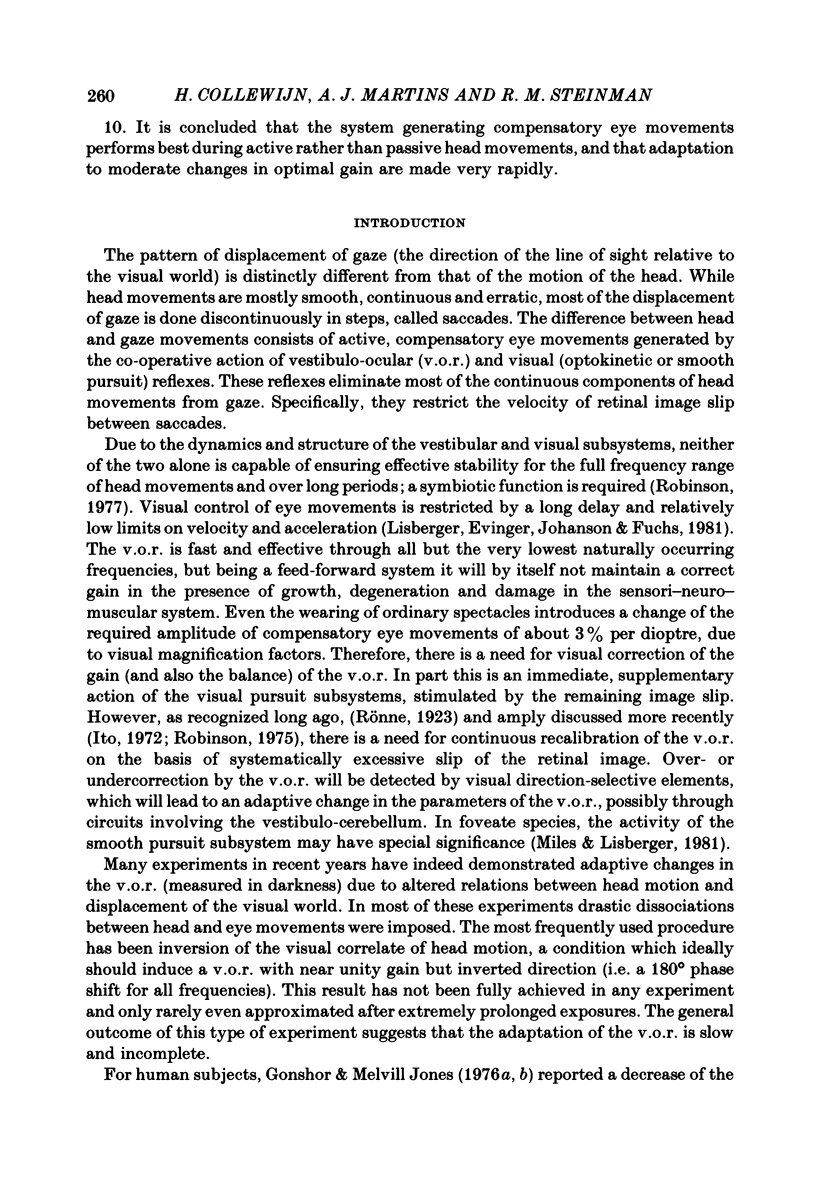

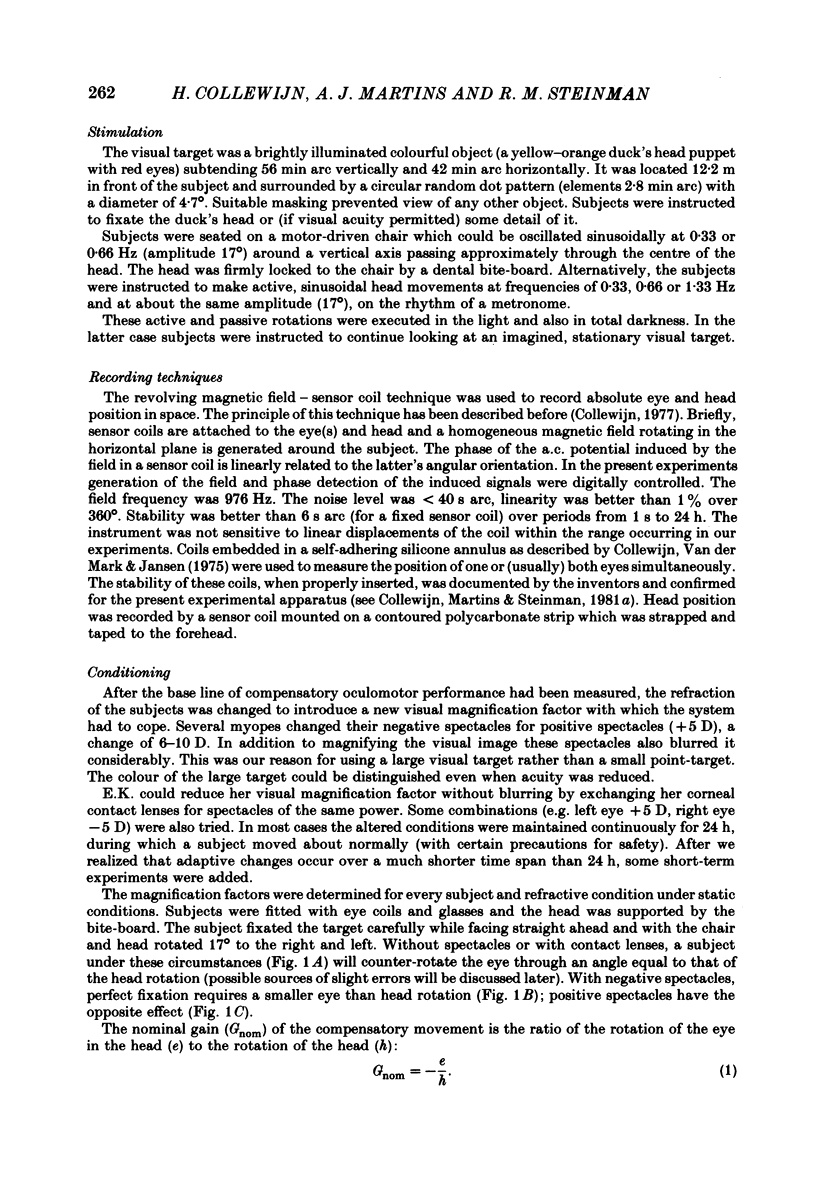

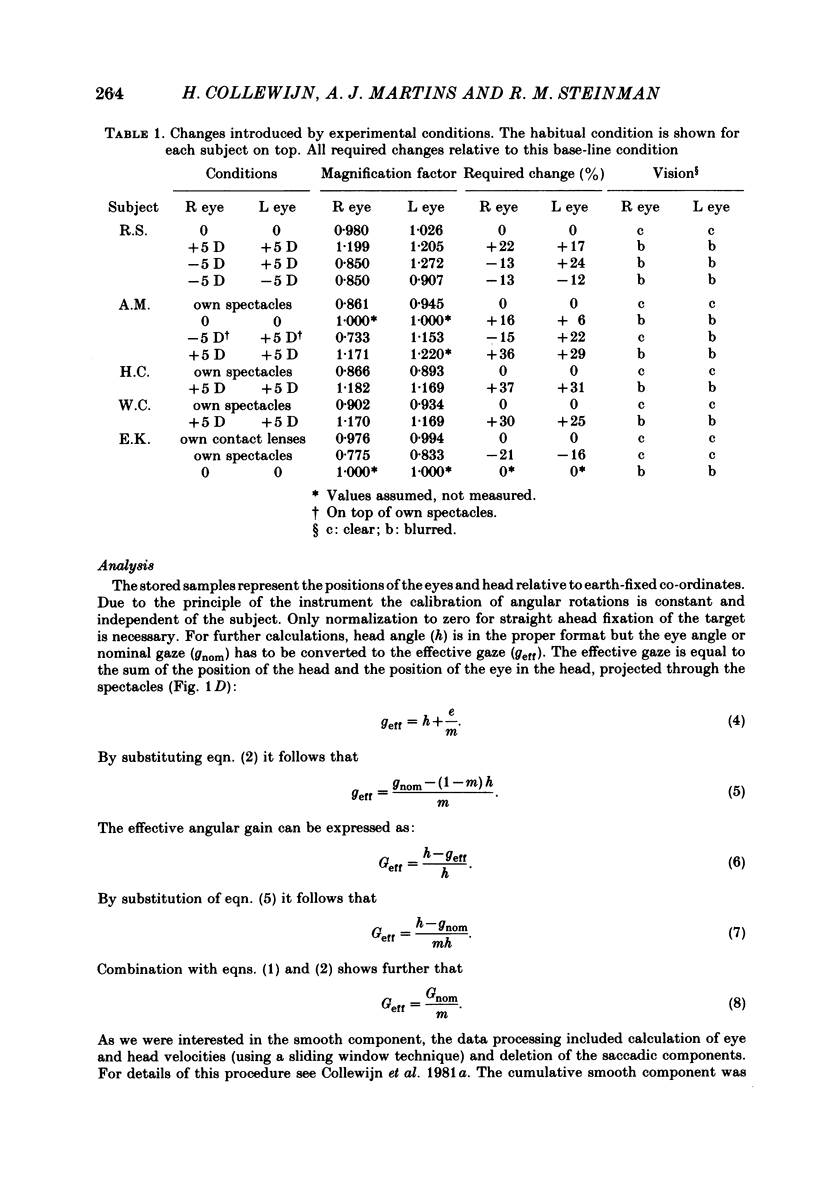
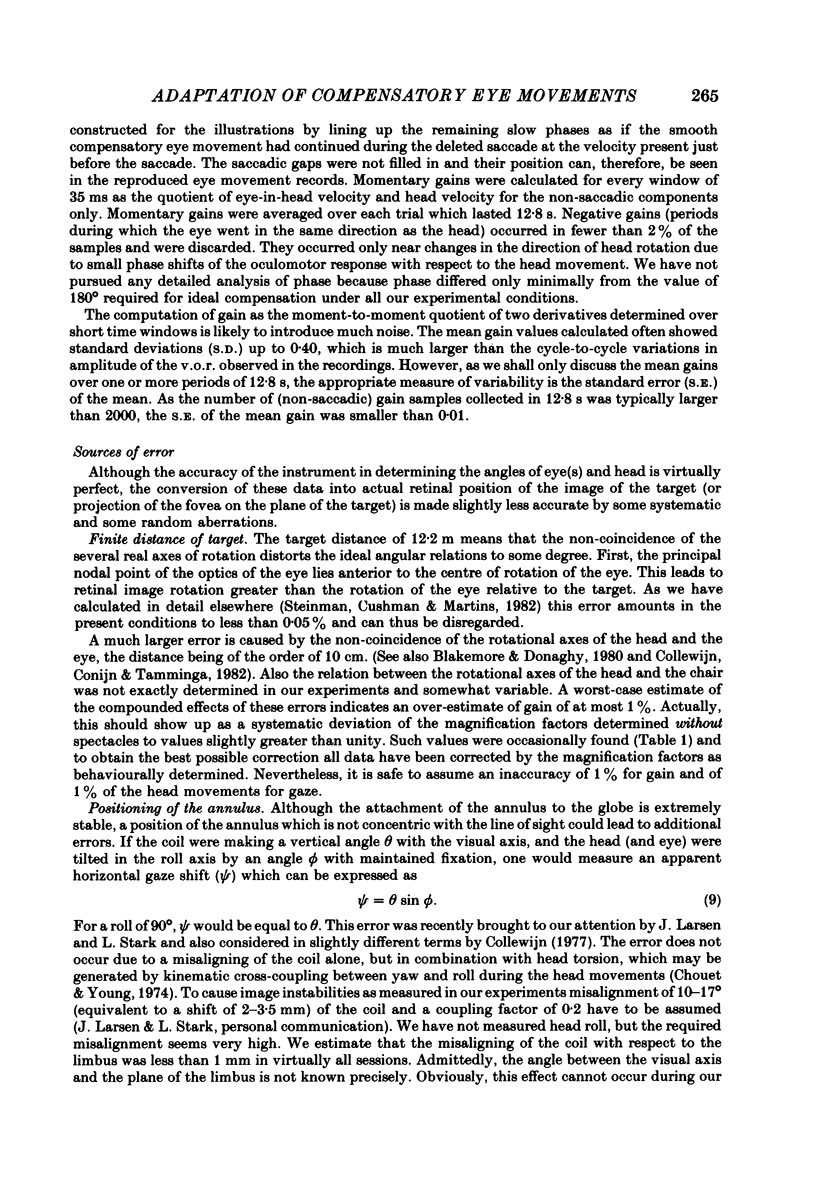



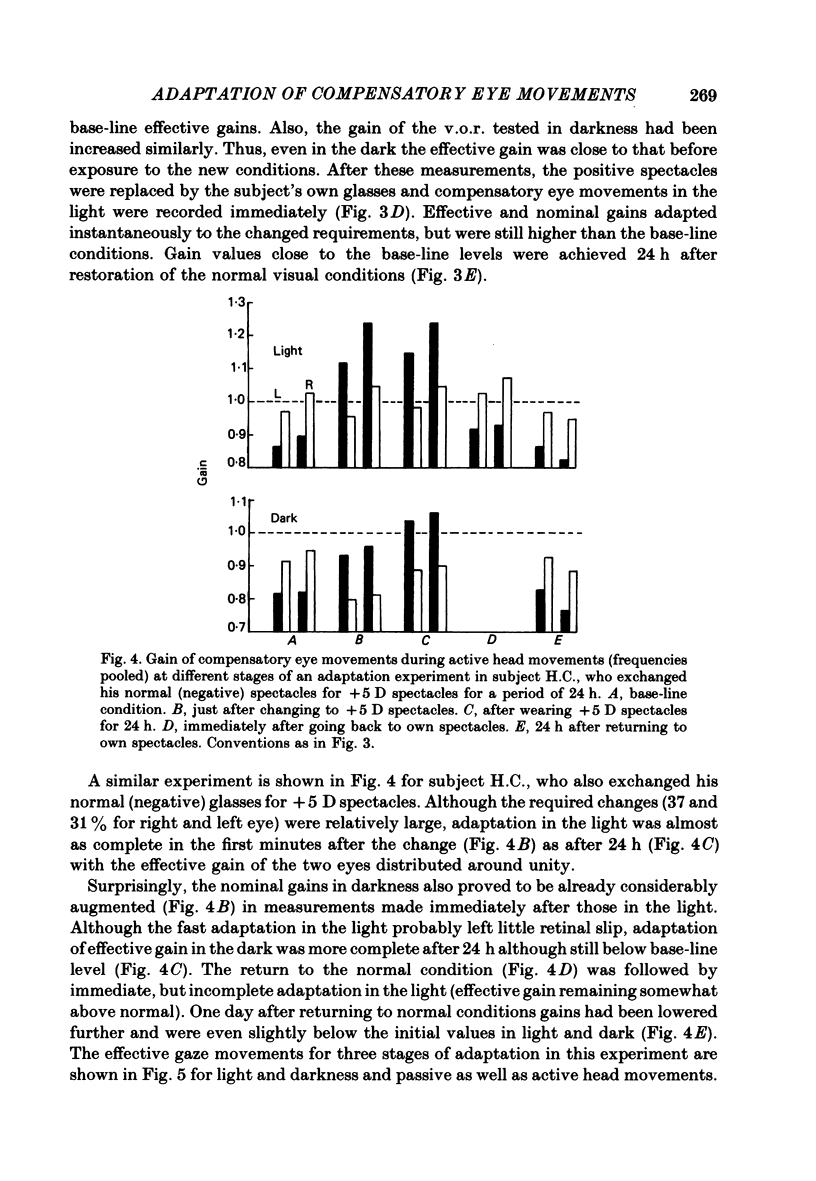


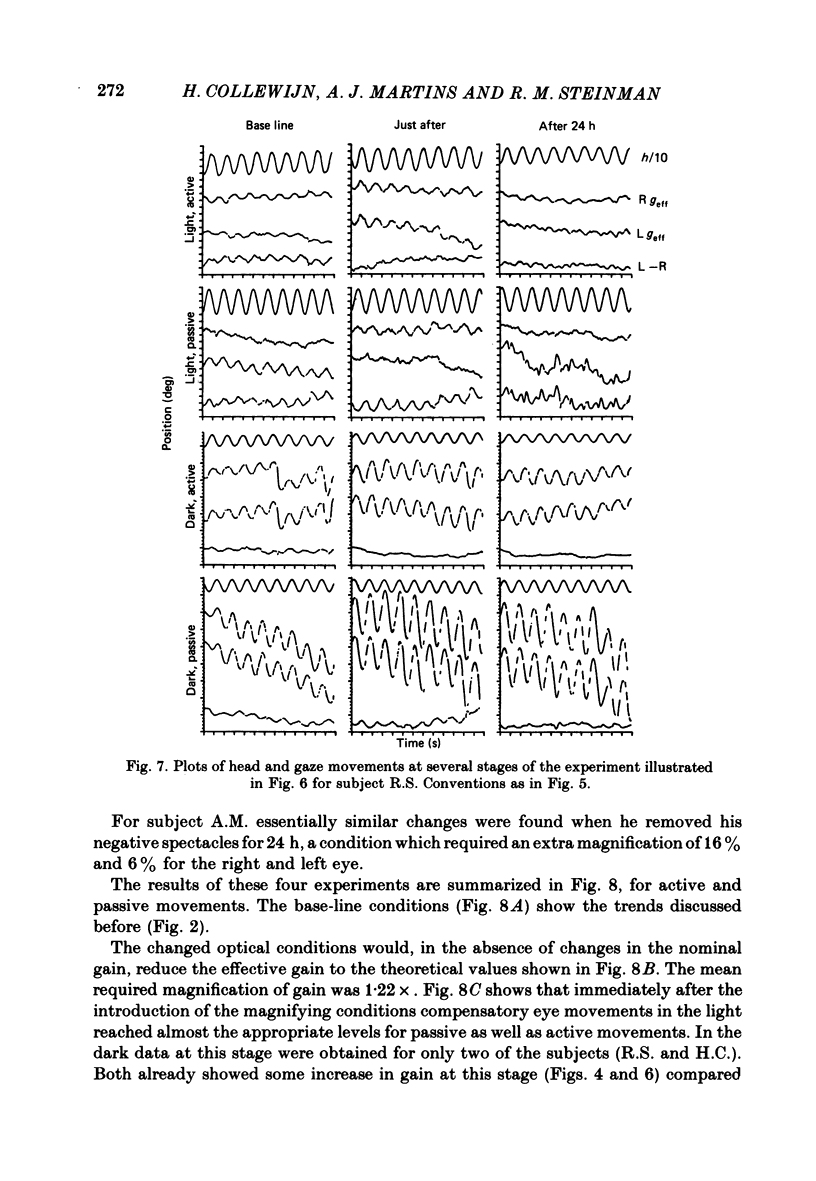

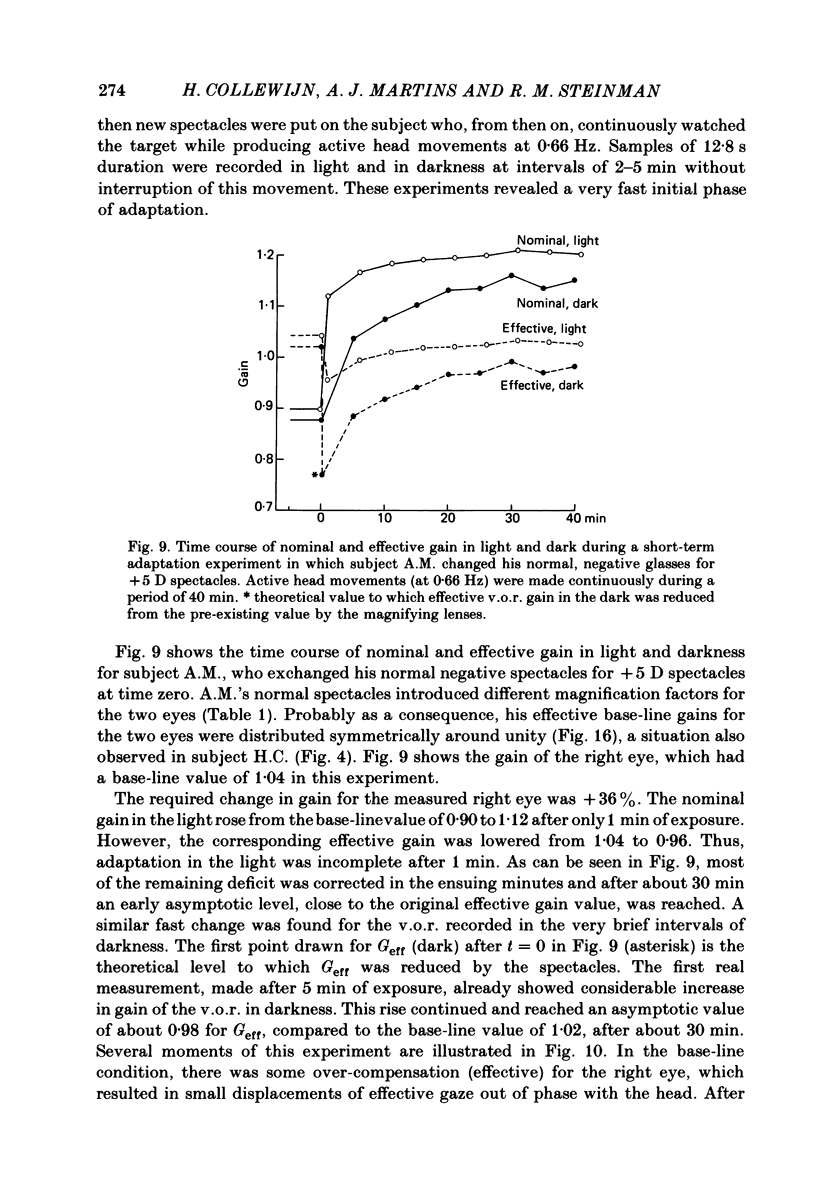
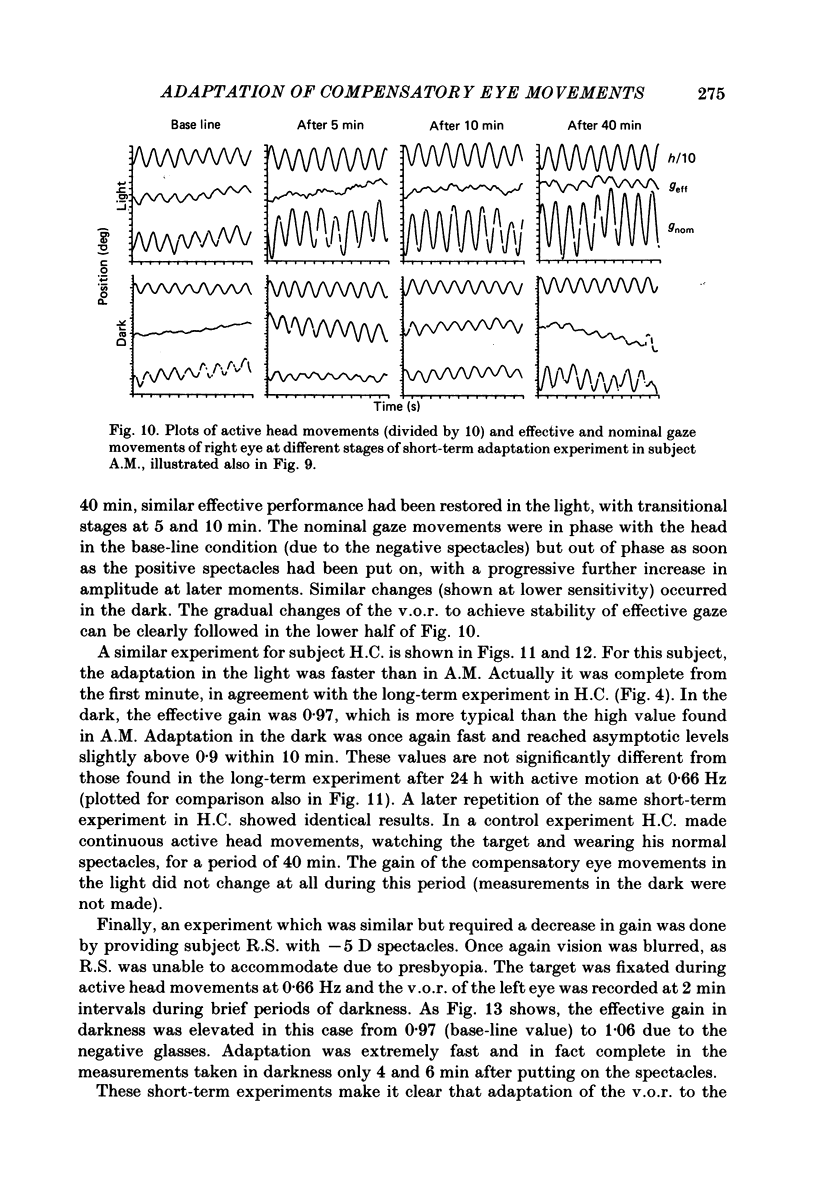
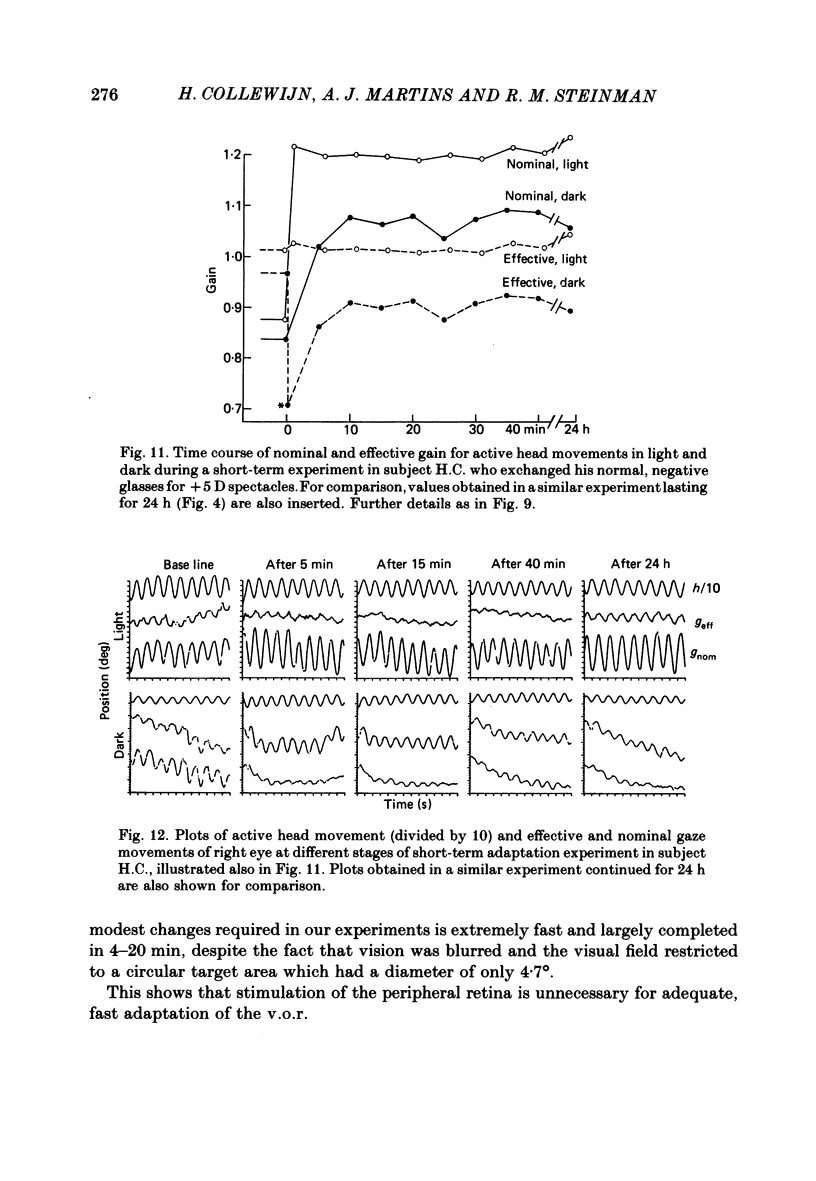
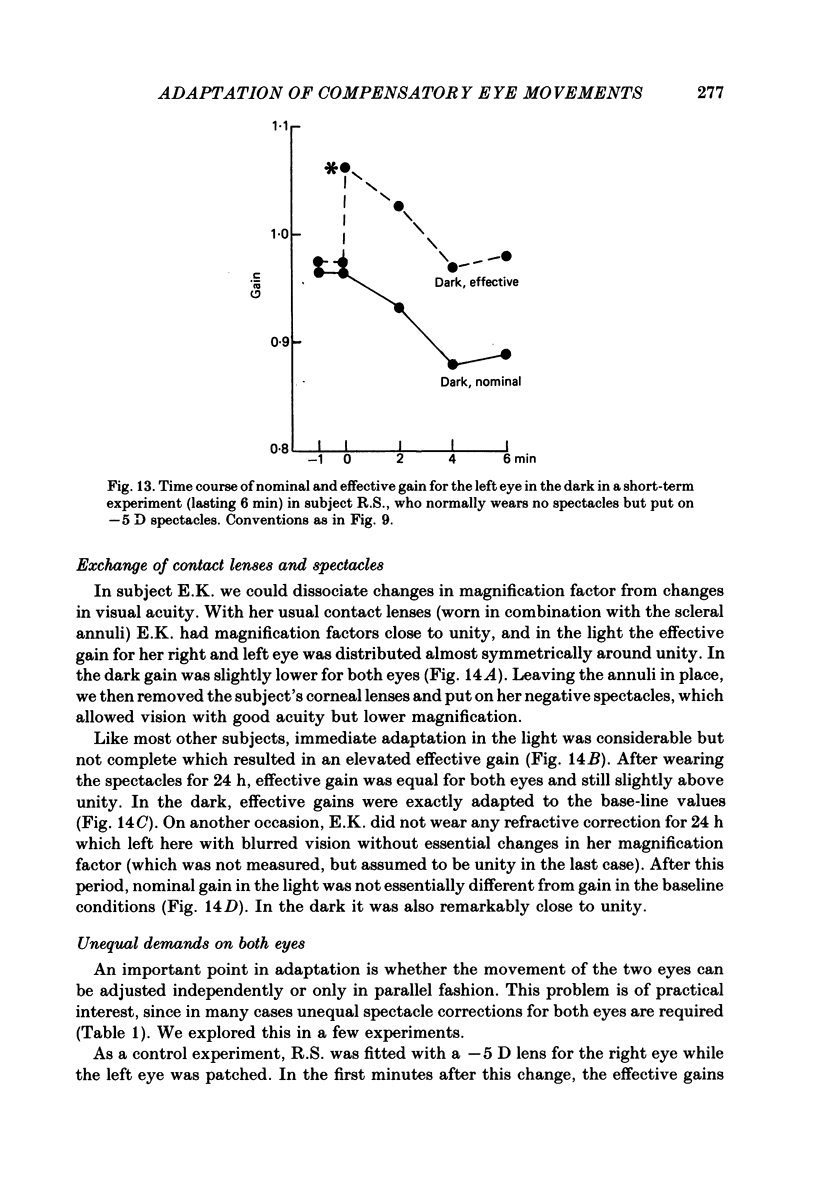

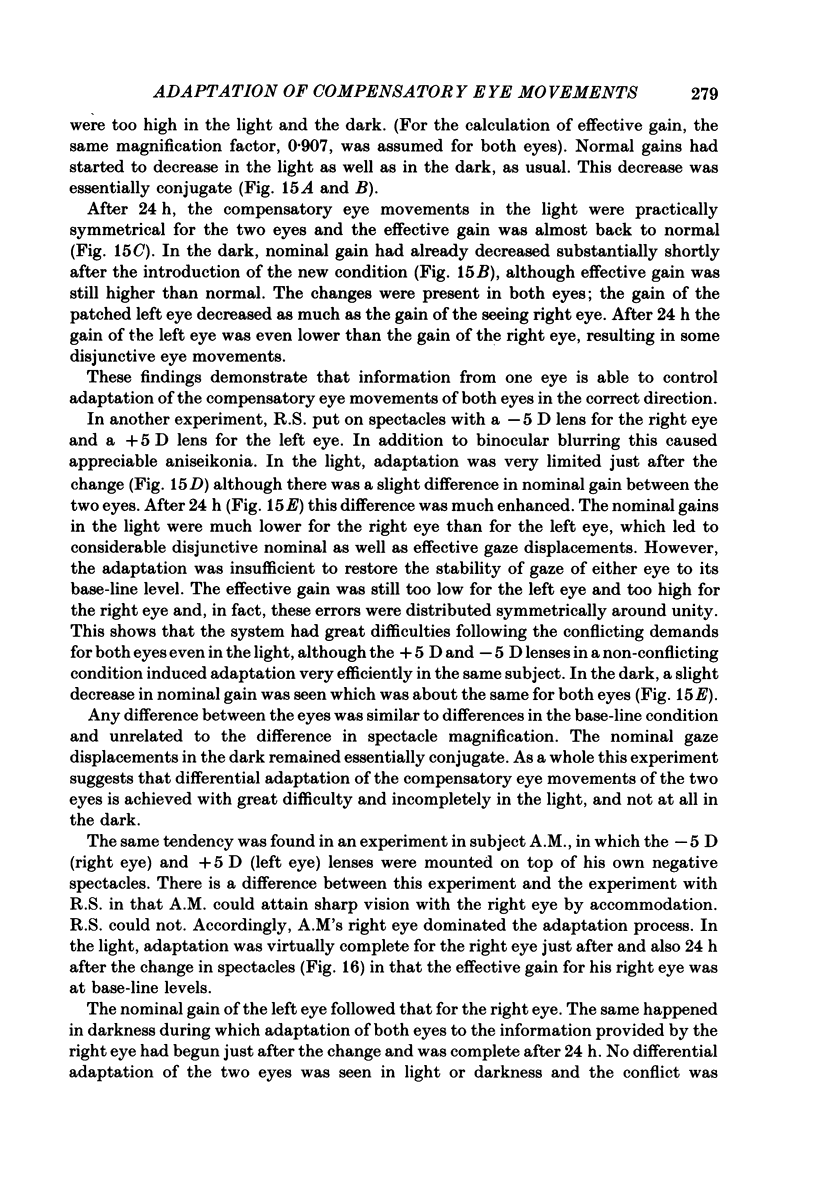



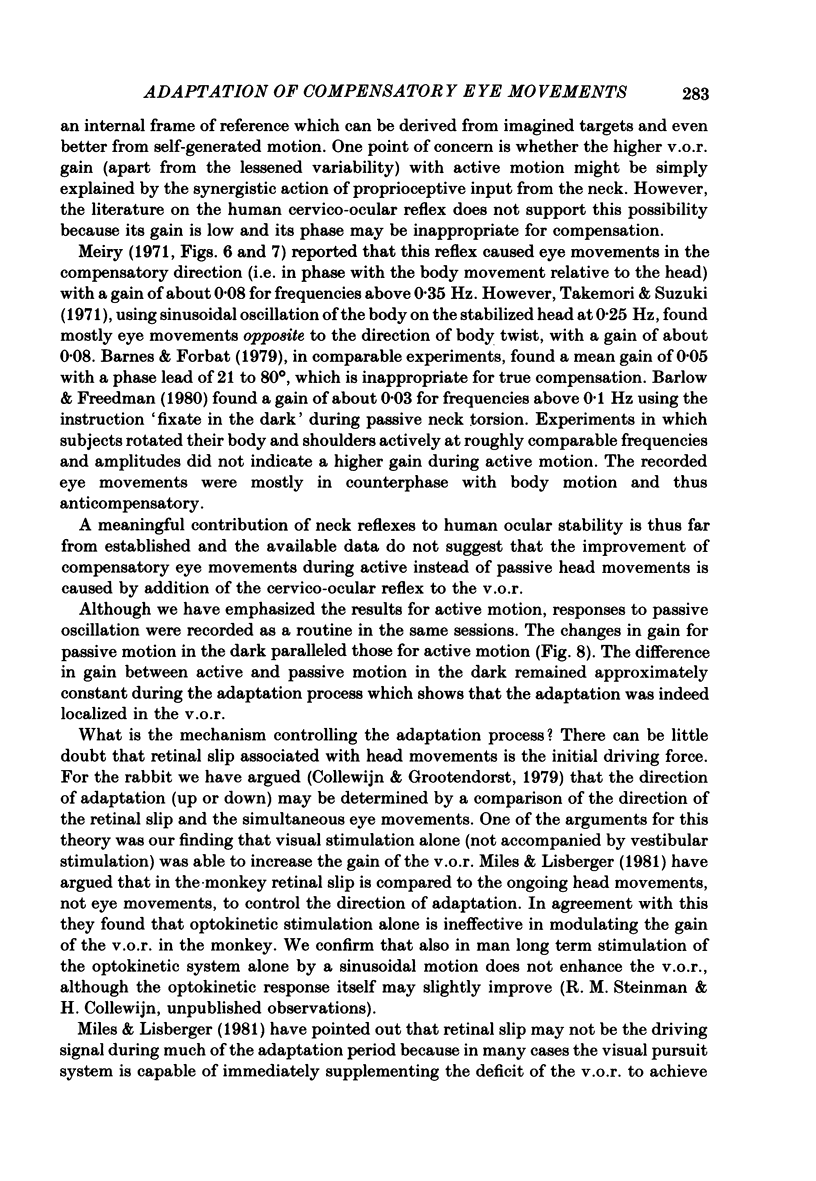
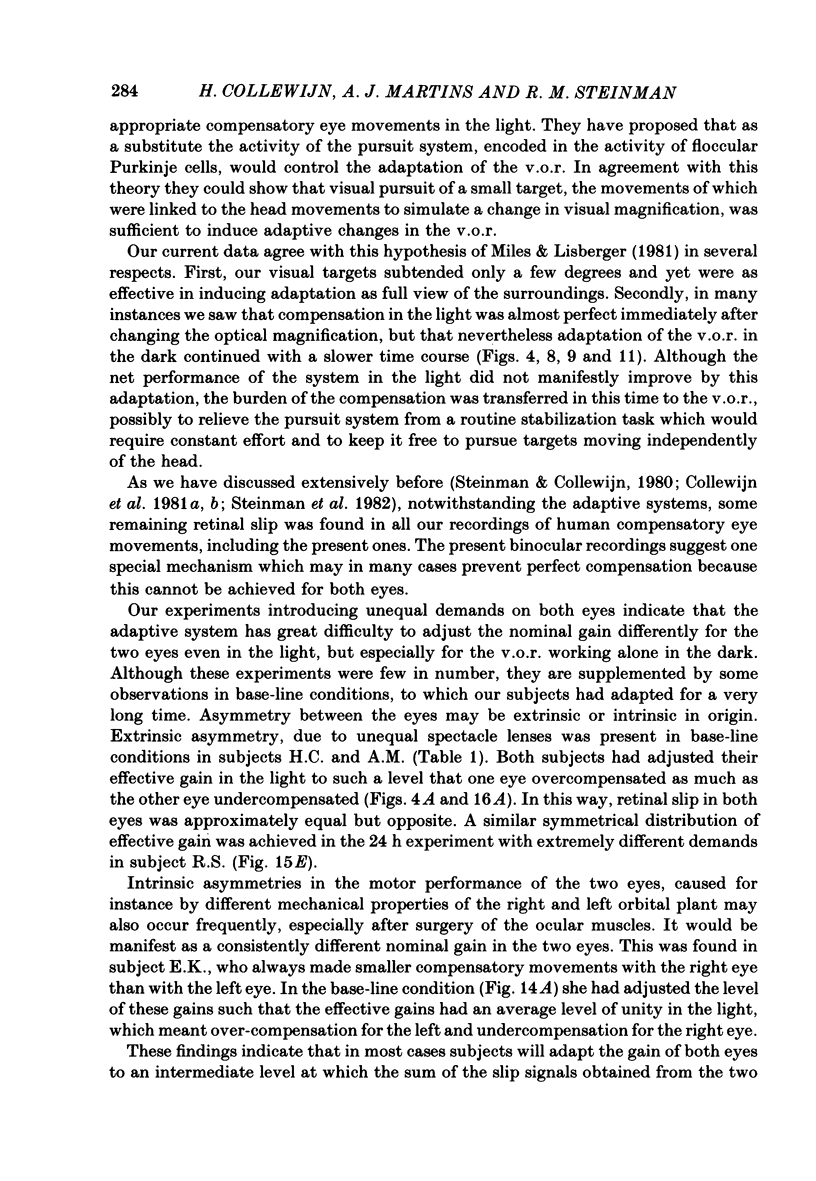
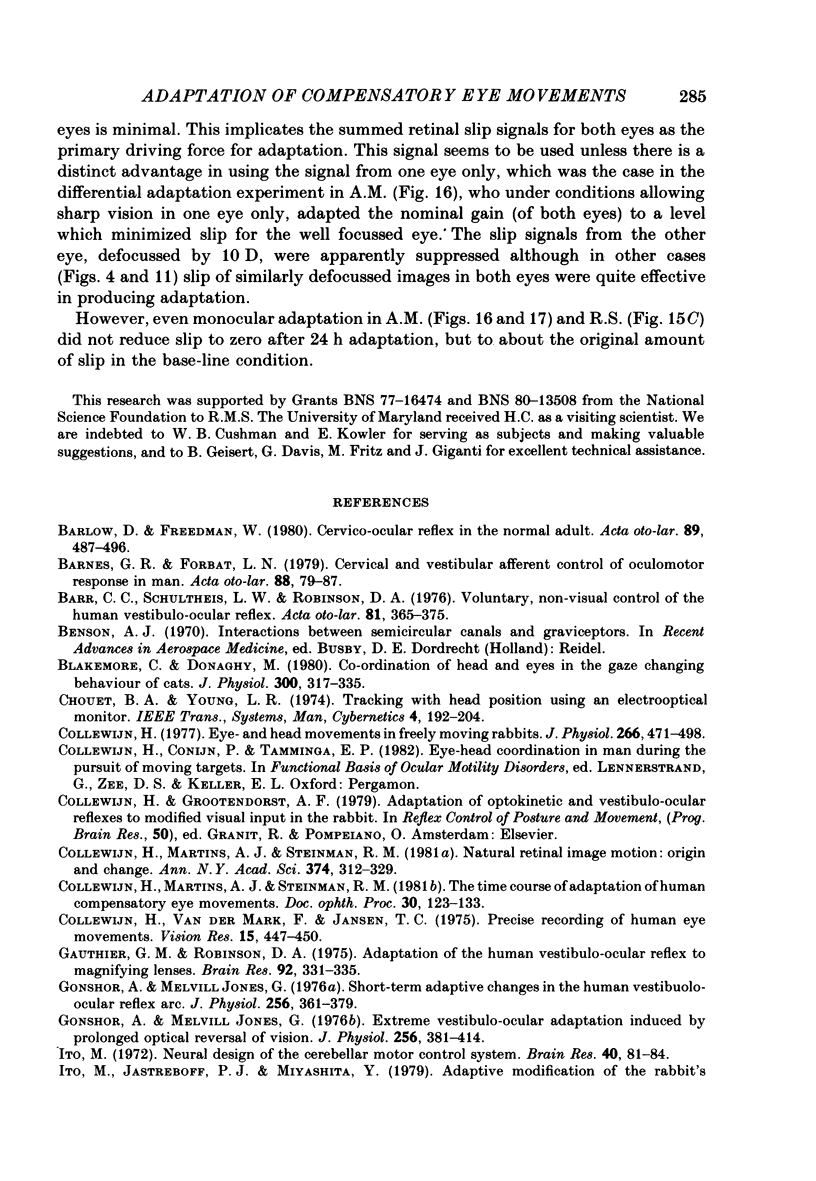
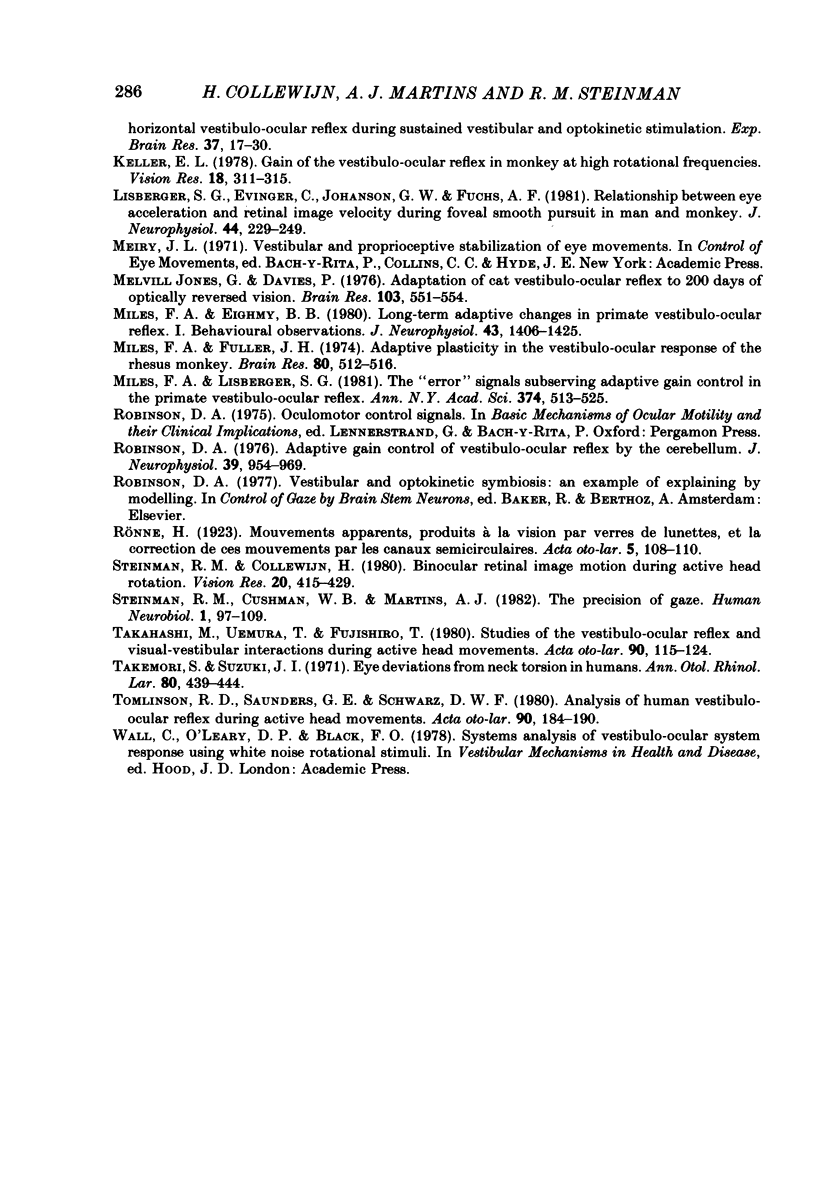
Selected References
These references are in PubMed. This may not be the complete list of references from this article.
- Barlow D., Freedman W. Cervico-ocular reflex in the normal adult. Acta Otolaryngol. 1980 May-Jun;89(5-6):487–496. doi: 10.3109/00016488009127166. [DOI] [PubMed] [Google Scholar]
- Barnes G. R., Forbat L. N. Cervical and vestibular afferent control of oculomotor response in man. Acta Otolaryngol. 1979;88(1-2):79–87. doi: 10.3109/00016487909137143. [DOI] [PubMed] [Google Scholar]
- Barr C. C., Schultheis L. W., Robinson D. A. Voluntary, non-visual control of the human vestibulo-ocular reflex. Acta Otolaryngol. 1976 May-Jun;81(5-6):365–375. doi: 10.3109/00016487609107490. [DOI] [PubMed] [Google Scholar]
- Blakemore C., Donaghy M. Co-ordination of head and eyes in the gaze changing behaviour of cats. J Physiol. 1980 Mar;300:317–335. doi: 10.1113/jphysiol.1980.sp013164. [DOI] [PMC free article] [PubMed] [Google Scholar]
- Collewijn H. Eye- and head movements in freely moving rabbits. J Physiol. 1977 Apr;266(2):471–498. doi: 10.1113/jphysiol.1977.sp011778. [DOI] [PMC free article] [PubMed] [Google Scholar]
- Collewijn H., Martins A. J., Steinman R. M. Natural retinal image motion: origin and change. Ann N Y Acad Sci. 1981;374:312–329. doi: 10.1111/j.1749-6632.1981.tb30879.x. [DOI] [PubMed] [Google Scholar]
- Collewijn H., van der Mark F., Jansen T. C. Precise recording of human eye movements. Vision Res. 1975 Mar;15(3):447–450. doi: 10.1016/0042-6989(75)90098-x. [DOI] [PubMed] [Google Scholar]
- Gauthier G. M., Robinson D. A. Adaptation of the human vestibuloocular reflex to magnifying lenses. Brain Res. 1975 Jul 11;92(2):331–335. doi: 10.1016/0006-8993(75)90279-6. [DOI] [PubMed] [Google Scholar]
- Gonshor A., Jones G. M. Extreme vestibulo-ocular adaptation induced by prolonged optical reversal of vision. J Physiol. 1976 Apr;256(2):381–414. doi: 10.1113/jphysiol.1976.sp011330. [DOI] [PMC free article] [PubMed] [Google Scholar]
- Gonshor A., Jones G. M. Short-term adaptive changes in the human vestibulo-ocular reflex arc. J Physiol. 1976 Apr;256(2):361–379. doi: 10.1113/jphysiol.1976.sp011329. [DOI] [PMC free article] [PubMed] [Google Scholar]
- Ito M., Jastreboff P. J., Miyashita Y. Adaptive modification of the rabbit's horizontal vestibulo-ocular reflex during sustained vestibular and optokinetic stimulation. Exp Brain Res. 1979 Sep;37(1):17–30. doi: 10.1007/BF01474250. [DOI] [PubMed] [Google Scholar]
- Ito M. Neural design of the cerebellar motor control system. Brain Res. 1972 May 12;40(1):81–84. doi: 10.1016/0006-8993(72)90110-2. [DOI] [PubMed] [Google Scholar]
- Jones G. M., Davies P. Adaptation of cat vestibulo-ocular reflex to 200 days of optically reversed vision. Brain Res. 1976 Feb 27;103(3):551–554. doi: 10.1016/0006-8993(76)90454-6. [DOI] [PubMed] [Google Scholar]
- Keller E. L. Gain of the vestibulo-ocular reflex in monkey at high rotational frequencies. Vision Res. 1978;18(3):311–315. doi: 10.1016/0042-6989(78)90165-7. [DOI] [PubMed] [Google Scholar]
- Lisberger S. G., Evinger C., Johanson G. W., Fuchs A. F. Relationship between eye acceleration and retinal image velocity during foveal smooth pursuit in man and monkey. J Neurophysiol. 1981 Aug;46(2):229–249. doi: 10.1152/jn.1981.46.2.229. [DOI] [PubMed] [Google Scholar]
- Miles F. A., Eighmy B. B. Long-term adaptive changes in primate vestibuloocular reflex. I. Behavioral observations. J Neurophysiol. 1980 May;43(5):1406–1425. doi: 10.1152/jn.1980.43.5.1406. [DOI] [PubMed] [Google Scholar]
- Miles F. A., Fuller J. H. Adaptive plasticity in the vestibulo-ocular responses of the rhesus monkey. Brain Res. 1974 Nov 22;80(3):512–516. doi: 10.1016/0006-8993(74)91035-x. [DOI] [PubMed] [Google Scholar]
- Miles F. A., Lisberger S. G. The "error" signals subserving adaptive gain control in the primate vestibulo-ocular reflex. Ann N Y Acad Sci. 1981;374:513–525. doi: 10.1111/j.1749-6632.1981.tb30896.x. [DOI] [PubMed] [Google Scholar]
- Robinson D. A. Adaptive gain control of vestibuloocular reflex by the cerebellum. J Neurophysiol. 1976 Sep;39(5):954–969. doi: 10.1152/jn.1976.39.5.954. [DOI] [PubMed] [Google Scholar]
- Steinman R. M., Collewijn H. Binocular retinal image motion during active head rotation. Vision Res. 1980;20(5):415–429. doi: 10.1016/0042-6989(80)90032-2. [DOI] [PubMed] [Google Scholar]
- Steinman R. M., Cushman W. B., Martins A. J. The precision of gaze. A review. Hum Neurobiol. 1982;1(2):97–109. [PubMed] [Google Scholar]
- Tomlinson R. D., Saunders G. E., Schwarz D. W. Analysis of human vestibulo-ocular reflex during active head movements. Acta Otolaryngol. 1980 Sep-Oct;90(3-4):184–190. doi: 10.3109/00016488009131714. [DOI] [PubMed] [Google Scholar]


